- Author Matthew Elmers [email protected].
- Public 2023-12-16 21:49.
- Last modified 2025-01-24 09:17.
Dogs bark -
The peddler came to the village.
Peaches in bloom …
Buson

Sengoku era samurai armor (children's armor in the center). The figures on the left and right are traditional armor with tight lacing. (Anne and Gabriel Barbier-Muller Museum, Dallas, TX)
However, this topic is so interesting that it makes sense to return to it at a new level. Which is primarily associated … with illustrative material. Previous articles on the topic of Japanese armor used mainly photographs from the Metropolitan Museum of Art in New York. In this article, we will get acquainted with the cuirass of Japanese samurai and their helmets of the Sengoku era based on photographs from a very interesting museum, by the way, also American - the Anna and Gabriel Barbier-Muller Museum, which is located in Dallas, Texas. Well, this is the same city where President Kennedy was shot. But, as you can see, it also has a very interesting museum of Japanese culture. So, if any of the visitors to the VO site suddenly finds himself in the USA in the city of Dallas (or already lives in the States, and does not know about it!), Then … he may well visit it and see with his own eyes everything that we are here and now see in the photos from this museum!
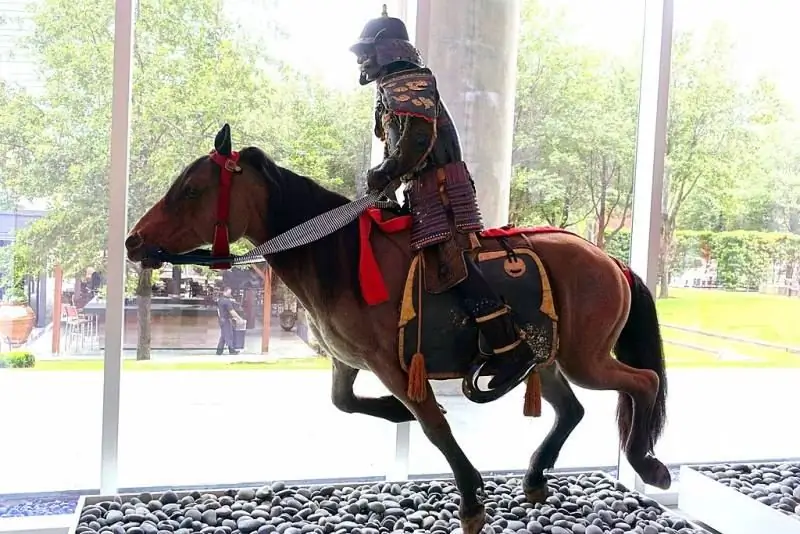
The figure of a samurai rider of the Edo era in the armor of hotoke-do.
Well, and we must start with the fact that since the ancient Japanese were horse archers, then the armor was originally, and subsequently, counted on protection from arrows. Therefore, unlike European ones, for a long time, chain mail was not used at all. All armor was plate. Breastplate - do (or ko - tortoise shell) was assembled from plates intertwined with cords. Either leather or silk. It is hardly worth mentioning the Japanese names of these plates here; it is more important to note that in the early armor of the Heian era, plates of three types were used: with three, two and one rows of holes, and later - narrower ones, with two and three rows. In traditional armor, o-yoroi plates with two and three rows of holes were superimposed on each other so that they overlap each other by two-thirds. Single-row plates were attached along the edges of the cuirass, which strengthened them even more.
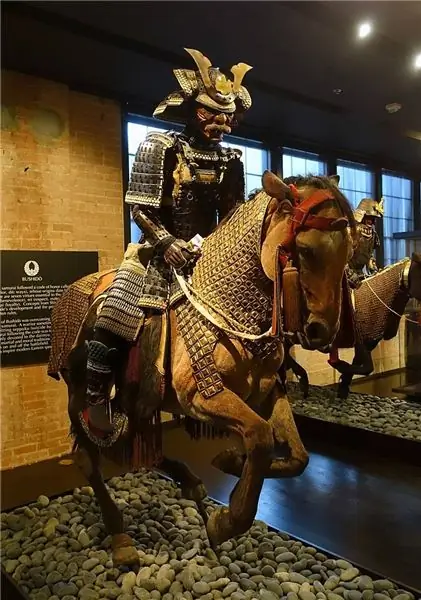
Mogami-do armor, which first appeared during the Onin-Bummei war era (1467 -1477), bugu horse harness and um-yoroi horse armor. The restoration of the armor was carried out in 1854.
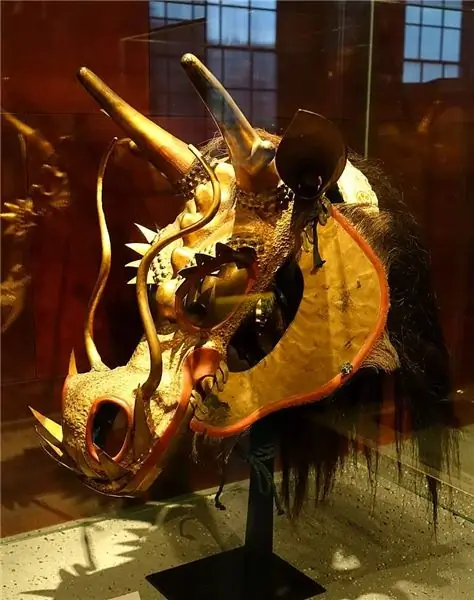
Umazura horse mask.
The records themselves were a real work of art. Firstly, they had a "lining" of leather, and secondly, they were repeatedly covered with the famous Japanese varnish from all sides, and secondly, chopped straw, and grated ceramic dust, and … dry earth, and gold and silver powder. Sometimes the metal was also wrapped in leather from the "face". That is, the plates were "plump" and, being held together by cords, also had good shock-absorbing properties. By the way, their upper part was either rounded or beveled, which is why the strips of armor from these plates in their upper part resembled a palisade.

Hon kozane ni-mai-do - two-piece armor. The helmet is signed by Echigo Munetsugo. Restoration around 1800 from the Edo period.
Now let's turn to the armor itself, and here we will tell you in more detail about them and give all their specific Japanese names. The reason for the appearance of the new armor, which will be discussed here, is simple.
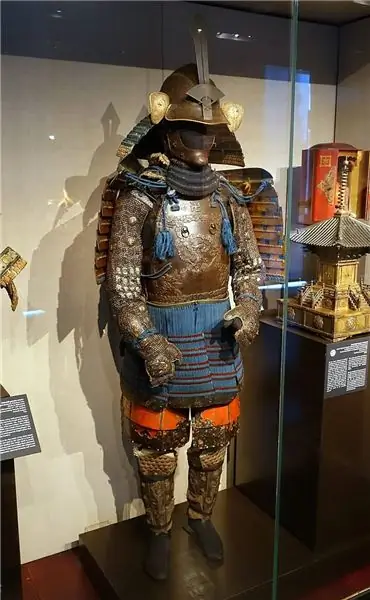
Armor with a chased cuirass - uchidashi-do.
The design of traditional o-yoroi was inconvenient. Rather, it was comfortable for the rider, but not for the infantryman. That is why, as more and more infantry warriors are attracted to the "army" of samurai, the armor has also changed. The dô-maru and haramaki-do armor appeared, the weight of which was distributed over the body more evenly and less tired of their owners. They were also distinguished by more rare lacing and, this is after 1543, the requirement to resist firearms.
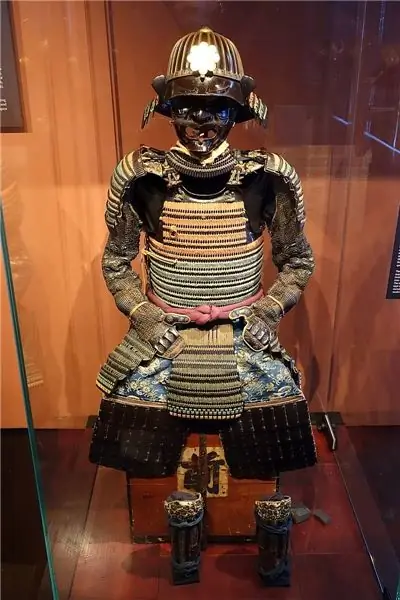
Hon kozane ni-mai-do Okudaira Nobimasa, 1600-1700
A method was also invented to facilitate their production. Now the plates were collected in strips, and those, in turn, were wrapped in leather, which was varnished. Five of these strips were interconnected with a sparse lacing and received a cuirass of five rows of stripes, covering the entire chest and abdomen. In addition, such a cuirass also lay on the hips, which reduced her pressure on the shoulders. Such armor received the general name tachi-do, which became the equivalent of the name tosei-do, or "new shell". These stripes themselves were now assembled from wide plates, but … since fashion is fashion, tradition is tradition, their upper edge was made toothed, so that it seemed as if these stripes were assembled from many small, traditional plates!
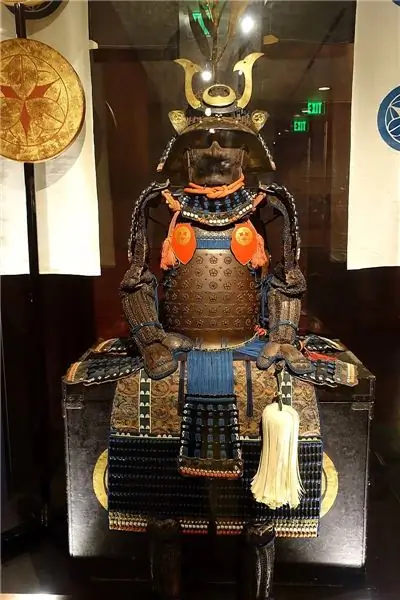
Okegawa-do with protruding rivet heads - byo-moji-yokohagi-okegawa-do, owned by Kojima Munenao.
Another analogue was the maru-do armor, which consisted of two halves - front and back and fastened to each other either with strings, or with a hinge on one side and strings on the other. Such cuirasses with a hinge even received a special name: ryo-takahi-mo-do and they turned out to be very convenient for soldiers of large armies. And it was also convenient to store and transport them!

Riders in tachi-do armor.
It can be considered quite amusing that the Japanese had many names for their armor, each emphasizing some of their characteristic features. So, all two-piece armor, regardless of what plates they were made from, could be called ni-mai-do. But if you had a cuirass of two sections, but made of real plates, then it could be called in another way - hon-kozane-ni-mai-do (that is, "ni-mai-do" from "real plates "). But if your records were "not real", then such a cuirass was called - kiritsuke-kozane-ni-mai-do. If the cuirass consisted not of two parts, but of five - one front, one back, one side (left) and two overlapping under the right hand, then, again, no matter what plates they were made of, their common it was like this: go-mai-do, but if the left plate was made of two parts connected by a hinge, then such a cuirass was called roku-mai-do. But if this six-piece cuirass was fastened with strings on each side, then it should have been called like this: ryo-tahimo-roku-mai-do!
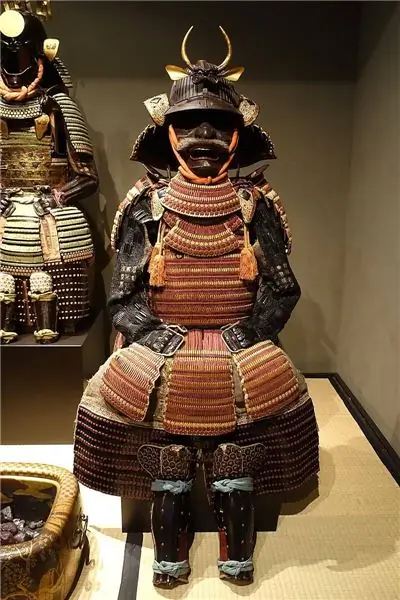
Hon kozane ni-mai-before 1702.
All these armors were popular until the middle of the 16th century and, it is clear that when they were created, the requirement for their comfort was put at the forefront. But since the middle of the century, the requirements for armor have changed again. Bullet resistance was the most important requirement that was now imposed on them. The okegawa-do armor appeared and became widespread, in which the cuirass was composed of smooth metal strips connected to each other without the use of lacing. Moreover, the fantasy of the masters who made them again turned out to be truly limitless. So, when the stripes were located horizontally on the cuirass, and the rivets connecting them were not visible, then such a cuirass was called yokohagi-okegawa-do.
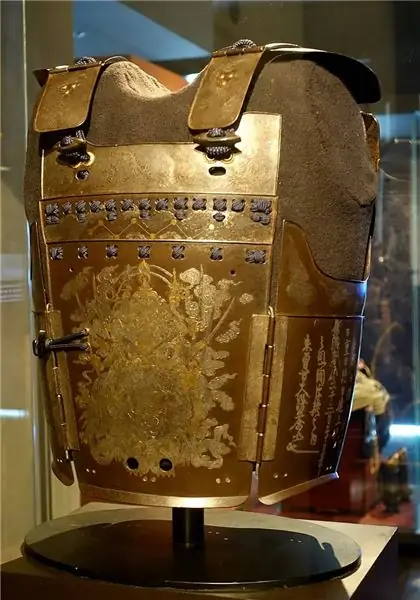
Typical Sendai-do armor, circa 1600
The most common "new type" armor is shown in the bottom illustration.
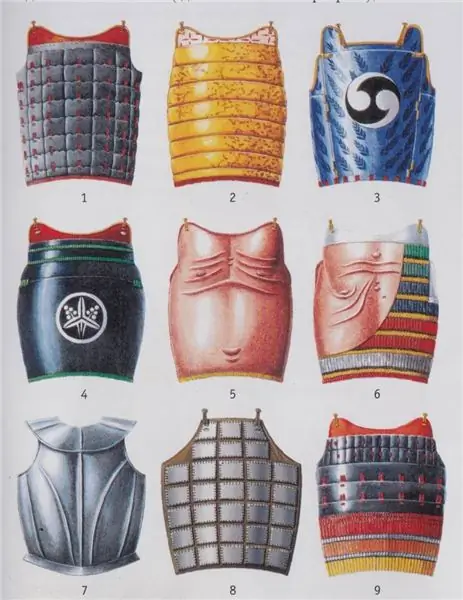
Types of cuirass do: 1 - nuinobe-do, 2 - yokohagi-okenawa-do, 3 - yukinoshita-do, 4 - hotoke-do, 5 - nio-do, 6 - katanugi-do, 7 - namban-do, 8 - tatami-do, 9 - dangae-do.
Please note that on the cuirass of many armor monas were depicted, the coats of arms of their owners. Moreover, this concerned not only the ashigaru, for whom it was an identification mark, but also the nobility, who did not need to be identified, but who, nevertheless, were proud of it. On armor made of plates, the image of the coat of arms was reproduced using weaving, and on flat surfaces of solid forged armor, it was either minted or made overhead.






